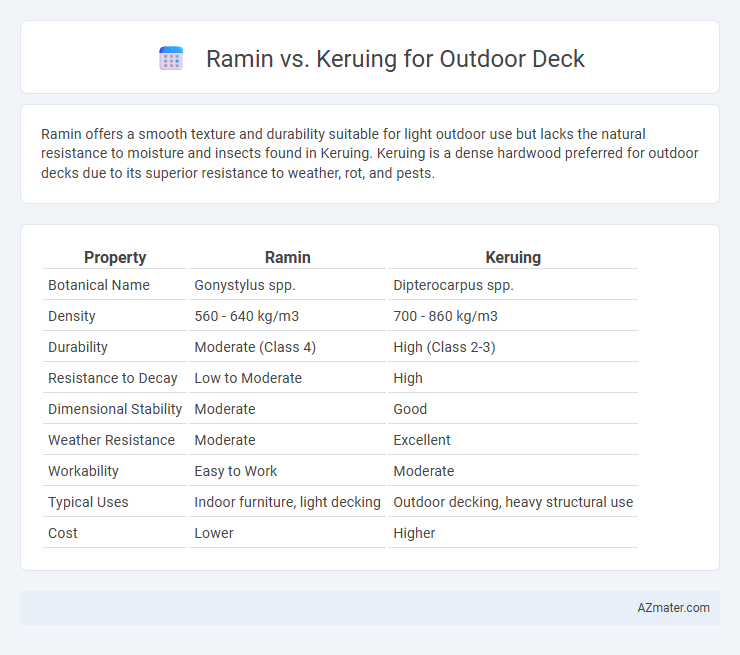Ramin offers a smooth texture and durability suitable for light outdoor use but lacks the natural resistance to moisture and insects found in Keruing. Keruing is a dense hardwood preferred for outdoor decks due to its superior resistance to weather, rot, and pests.
Table of Comparison
| Property | Ramin | Keruing |
|---|---|---|
| Botanical Name | Gonystylus spp. | Dipterocarpus spp. |
| Density | 560 - 640 kg/m3 | 700 - 860 kg/m3 |
| Durability | Moderate (Class 4) | High (Class 2-3) |
| Resistance to Decay | Low to Moderate | High |
| Dimensional Stability | Moderate | Good |
| Weather Resistance | Moderate | Excellent |
| Workability | Easy to Work | Moderate |
| Typical Uses | Indoor furniture, light decking | Outdoor decking, heavy structural use |
| Cost | Lower | Higher |
Introduction: Ramin vs Keruing for Outdoor Decking
Ramin and Keruing are popular hardwood choices for outdoor decking due to their durability and natural resistance to weather conditions. Ramin features a fine, uniform texture with a light cream to pale yellow hue, making it ideal for a smooth, elegant deck surface. Keruing offers a denser, coarser grain with rich reddish-brown tones and exceptional strength, providing increased resistance to heavy foot traffic and outdoor elements.
Wood Origins and Botanical Profiles
Ramin (Gonystylus spp.) originates from Southeast Asia, predominantly Malaysia and Indonesia, known for its light yellowish-brown hue and fine, uniform texture, making it ideal for outdoor decks due to its moderate durability and resistance to decay. Keruing (Dipterocarpus spp.) is sourced mainly from Malaysia, Indonesia, and the Philippines, characterized by its reddish-brown color, coarse grain, and high density, offering excellent strength and natural resistance to weather elements. Both woods belong to tropical hardwood families, with Ramin part of the Thymelaeaceae family and Keruing within Dipterocarpaceae, influencing their botanical and durability traits critical for outdoor applications.
Durability and Lifespan in Outdoor Environments
Ramin and Keruing are both commonly used hardwoods for outdoor decking, but Keruing offers superior durability and lifespan in outdoor environments due to its higher density and natural resistance to moisture, rot, and insect damage. Ramin, while lightweight and easier to work with, tends to be less durable and may require more frequent maintenance to prevent weather-related deterioration. Keruing's robust properties make it ideal for long-term outdoor use, ensuring deck longevity and reduced replacement costs.
Resistance to Weather, Decay, and Insects
Ramin wood offers moderate resistance to weather conditions but is less durable against decay and insect attacks compared to Keruing. Keruing is highly valued for outdoor decking due to its superior resistance to moisture, fungal decay, and wood-boring insects, making it ideal for harsh climates. Its dense, oily grain structure enhances longevity and reduces maintenance requirements in exposed outdoor environments.
Maintenance Requirements and Care Tips
Ramin wood requires minimal maintenance due to its natural resistance to rot and insects, making it ideal for outdoor decks in moderate climates, whereas Keruing demands more frequent sealing and protective treatments to prevent moisture damage and fungal growth. Regular cleaning with mild soap and water extends the lifespan of Ramin decks, while Keruing decks benefit from annual sanding and oiling to maintain their structural integrity and appearance. Both woods should be inspected regularly for signs of wear, but Keruing's higher porosity necessitates more diligent moisture control to avoid warping or cracking.
Appearance: Color, Grain, and Aesthetic Appeal
Ramin wood features a pale yellow to light brown color with a fine, straight grain, lending a smooth, uniform appearance ideal for sleek outdoor decks. In contrast, Keruing showcases a richer reddish-brown hue with a more pronounced, interlocking grain that adds a rustic, textured aesthetic to decking surfaces. The choice between Ramin and Keruing depends on desired aesthetic appeal, with Ramin providing a lighter, more subtle look and Keruing offering deeper color tones and distinctive grain patterns for a bold outdoor deck design.
Sustainability and Environmental Impact
Ramin wood, sourced responsibly from Southeast Asian plantations, offers greater sustainability compared to Keruing, which is often harvested from natural tropical forests, leading to deforestation concerns. The slower growth rate and limited regeneration of Keruing make it less environmentally friendly, whereas Ramin's managed cultivation supports forest conservation and biodiversity. Choosing Ramin for outdoor decks reduces carbon footprints and preserves natural habitats due to better forestry practices and certification standards like FSC.
Cost Comparison: Ramin vs Keruing
Ramin wood typically costs less than Keruing, making it a budget-friendly option for outdoor decking projects. While Keruing is pricier, it offers superior durability and resistance to weathering, which can reduce long-term maintenance expenses. Choosing between Ramin and Keruing depends on balancing upfront costs against the potential for extended lifespan and lower upkeep.
Installation Considerations and Workability
Ramin wood offers easier workability with its fine grain and softer texture, making it simpler to cut, nail, and shape during outdoor deck installation. Keruing, known for its density and hardness, requires specialized tools for cutting and handling but provides enhanced durability and resistance to wear in outdoor conditions. Installation of Ramin demands careful sealing and treatment to prevent moisture damage, whereas Keruing's natural oil content offers better resistance, reducing maintenance needs over time.
Conclusion: Choosing the Right Wood for Your Deck
Ramin offers an affordable, smooth-finished option with good durability for outdoor decks, making it suitable for budget-conscious projects in moderate climates. Keruing provides superior hardness, natural resistance to decay, and a robust structure, ideal for decks exposed to harsh weather and heavy foot traffic. Selecting the right wood depends on balancing cost, environmental conditions, and desired longevity, with Keruing favored for long-term durability and Ramin for cost-effective, moderate-use decking.

Infographic: Ramin vs Keruing for Outdoor Deck
 azmater.com
azmater.com